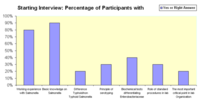- Research capacity building
- Training and education
- Technical and advisory services
- Networking
- Search engines and reference lists
- Editorial support
Feedback analysis
Starting interview
Before the training, a short questionnaire was distributed to the participants to assess their knowledge (Figure 1).
- Most (80%) of participants have experience with Salmonella in their work including isolation of Salmonella from meat, feces, raw milk, animal feed and water, eggs…
- Most of participants (90%) have a basic knowledge about Salmonella.
- 20% of participants can give the difference between Typoid and non Typhoid Salmonella.
- 30% of participants can state the principle of serotyping based on plate sero-agglutination.
- 40% of participants could mention more than 2 different biochemical tests to differentiate Enterobacteriaceae.
- 30% mentioned the importance of standardization procedure for comparable results in research or diagnostic.
- 20% mentioned cross-contaminations as an important critical point in the laboratory organization influencing the quality of the results.

Figure 1 : starting interview
This quick interview before starting the course confirmed the need of a training course on Salmonella, which is one of the most important food borne zoonosis worldwide, including in Vietnam, where food poisoning cases have already been reported by the national surveillance system. Furthermore, this test helped the instructors focusing on what should be instructed to the participants.
Participants' knowledge evaluation after the training period
After the course, an evaluation form was distributed to the participants to assess the benefit of the training period in term of knowledge (Figure 2).

Figure 2 : end evaluation
Participants’ feedback
Finally, the participants were asked to give their opinion about the training period.
The most appreciated component of the training was its practical aspect (Figure 3).This confirms that this training was meeting the demand expressed by the participants of the training in 2005, asking for more practice.

Very few critics were formulated by the participants about possible improvement or missing content in the training, most of them whished a longer training period in order to practice and learn even more (Figure 4 and 5).

Figure 4: What should be improved? |

Figure 5: What was missing? |
The main techniques learned by the participants and susceptible to be applied in their future work are mentioned in Figure 6. This confirms that the participants learned a broad panel of techniques and that they enjoyed and considered as most useful the serotyping of Salmonella, what is, according to our knowledge, currently not practiced in Vietnamese laboratory, excepted in the national reference laboratory for foodborne diseases.

Figure 6: Knowledge and techniques learned and potentially used in daily work
The suggestions summarized in Figure 7 for a next training were eather on other techniques (PCR, more serotyping, molecular techniques, etc) or on other foodborne pathogens (Campylobacter, Listeria, etc).

In conclusion, the organizers would like to warmly thank all participants for their interest, their active participation, and their manipulation with meticulous care. This training was for us very rich of exchanges with very dynamic and competent researchers. We are looking forward to working with you again.
Comments
CIRAD © 2007 (All rights reserved) - Disclaimer stating - Page updated : 23/05/2007